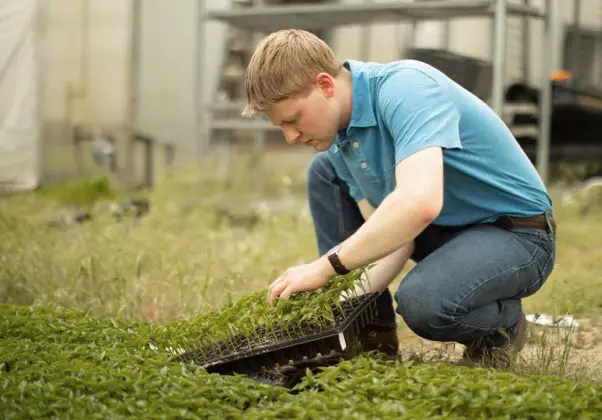Food Processing & Production Pathway
A Student Cook?
Does your student binge-watch cooking shows? Do they love trying out new recipes or even making up their own? Do they have an interest in cooking up new foods in a lab? Then they might be perfect for a career in food processing and production.
Home chefs can easily translate their skills to a restaurant atmosphere. And those who are more scientifically inclined may want to seek a career as an agricultural or food scientist. Agricultural and food scientists conduct research and experiments to improve the productivity and sustainability of field crops and farm animals; create new food products; and develop new and better ways to grow, process, package, and deliver food products. Agriculture and food science technicians support them in this important work.
Gain real-world skills through project-based learning.
For those who pursue this pathway, Stride Career Prep* offers a rigorous, project-based learning curriculum designed to hone their problem-solving, communication, critical thinking, and team collaboration skills. This curriculum is taught by experienced food science professionals and includes courses in culinary arts, food production, and agriscience.
Our Food Processing & Production Pathway Curriculum in Detail
All of our students take the core courses required for high school graduation in their state. The chart below shows the additional classes your student will take as an Agribusiness student. You can see the rest of the curriculum by viewing the full course list.
CAREER EXPLORATION COURSES
These courses provide an opportunity for students to gain insight into potential careers.
CAREER FOUNDATION COURSES
These courses are building blocks that prepare students for more specialized pathway courses.
CAREER PREPARATION COURSES
These courses prepare students for industry-recognized certification exams.
OPTIONAL CAREER LEARNING COURSES
While not required, these courses provide an opportunity for students to gain knowledge and skills that are useful in their chosen careers.
Agriculture Explorations
OR
Agriscience 1
Principles of Agriculture, Food & Natural Resources
General Agriscience 2
Food Production 1
Food Technology†
Livestock and Poultry Production 1
Livestock and Poultry Production 2
Livestock and Poultry Production 3
Note: Pathway courses are subject to change.
†New in fall 2022
Get ahead of the competition.
We encourage students to jumpstart the job search by helping them create a professional résumé, cover letter, and profile on Tallo, the leading professional networking platform for Gen Z. Plus, they connect virtually to working business professionals and entrepreneurs through Nepris.**
Find a school near you that offers food processing and production.
Stride Career Prep programs** with the Food Processing and Production pathway are available at tuition-free K12-powered, public online schools in the following states:
Don’t see your state? Check out the tuition-based option here in the Food Processing & Production Pathway. There are also tuition-free options in related fields like the Agribusiness Pathway.
Choose a career. Prepare for the future.
Cut, trim, or prepare consumer-sized portions of meat for use or sale in retail establishments. Most butchers work in grocery stores, although some work in meat processing plants or restaurants.
2021 Median Salary
$36,050
Expected Job Growth Rate for 2020–2030
Declining
Typical Entry-Level Education
No formal education credential
This data reflects the information available from the Bureau of Labor Statistics, U.S. Department of Labor, Occupational Outlook Handbook on July 1, 2022. To learn more about this occupation, visit bls.gov/ooh/production/butchers-and-meat-cutters.htm.
Dietitians and nutritionists plan and conduct food service or nutritional programs to help people lead healthy lives. They work in many settings, including hospitals, nursing homes, clinics, cafeterias, and state and local governments.
2021 Median Salary
$61,650
Expected Job Growth Rate for 2020–2030
Faster than average
Typical Entry-Level Education
Bachelor’s degree
This data reflects the information available from the Bureau of Labor Statistics, U.S. Department of Labor, Occupational Outlook Handbook on July 1, 2022. To learn more about this occupation, visit bls.gov/ooh/healthcare/dietitians-and-nutritionists.htm.
Chefs and head cooks oversee the daily food preparation at restaurants and other places where food is served. They hire, train, and supervise kitchen staff; develop recipes; plan menus; and manage the ordering and inventory of ingredients. Shift work is frequently required.
2021 Median Salary
$50,160
Expected Job Growth Rate for 2020–2030
Much faster than average
Typical Entry-Level Education
High school diploma or equivalent
This data reflects the information available from the Bureau of Labor Statistics, U.S. Department of Labor, Occupational Outlook Handbook on July 1, 2022. To learn more about this occupation, visit bls.gov/ooh/food-preparation-and-serving/chefs-and-head-cooks.htm.
Agricultural and food scientists conduct research and experiments to improve the productivity and sustainability of field crops and farm animals; create new food products; and develop new and better ways to grow, process, package, and deliver them. Most agriculture and food scientists focus on a particular subspecialty, such as improving the productivity and health of domestic farm animals (animal scientists); the productivity, management, and conservation of high-quality soil (soil scientists); increasing crop yields and controlling pests and weeds (plant scientists); or food processing, preserving, packaging and distribution techniques (food scientists and technologists).
2021 Median Salary
$74,160
Expected Job Growth Rate for 2020–2030
Average
Typical Entry-Level Education
Bachelor’s degree
This data reflects the information available from the Bureau of Labor Statistics, U.S. Department of Labor, Occupational Outlook Handbook on July 1, 2022. To learn more about this occupation, visit bls.gov/ooh/life-physical-and-social-science/agricultural-and-food-scientists.htm.
FAQs
A great way to prepare for a career as a chef while still in high school is to learn how to cook fast and well. You can do that by cooking for your family, of course, but there’s no substitute for cooking in a commercial kitchen, where you’ll be required to cook dozens of dishes in a high-pressure, time-sensitive environment. You can get a job as a line cook or in food prep for a local restaurant!
Dietitians and nutritionists typically need a bachelor’s or higher degree in dietetics, food and nutrition, or a related field to enter the occupation. Many dietitians and nutritionists have advanced degrees. Dietitians and nutritionists typically receive supervised training, usually in the form of an internship following graduation from college. Some schools offer coordinated programs in dietetics that allow students to complete supervised training as part of their undergraduate- or graduate-level coursework.
*Stride Career Prep is a program for students in grades 9–12. At some schools, career exploration is offered in middle school. Opportunities vary by school. Please visit your school page or check with your school counselor to find out what’s available in your area.
**Many Microsoft®️ Office certificates can be earned after completing one course. Other certificates require more classes to be better prepared, and students who participate in the program for at least two years will have further preparation for certification testing.
***Opportunities vary by school; please visit your school page or check with your school counselor.















